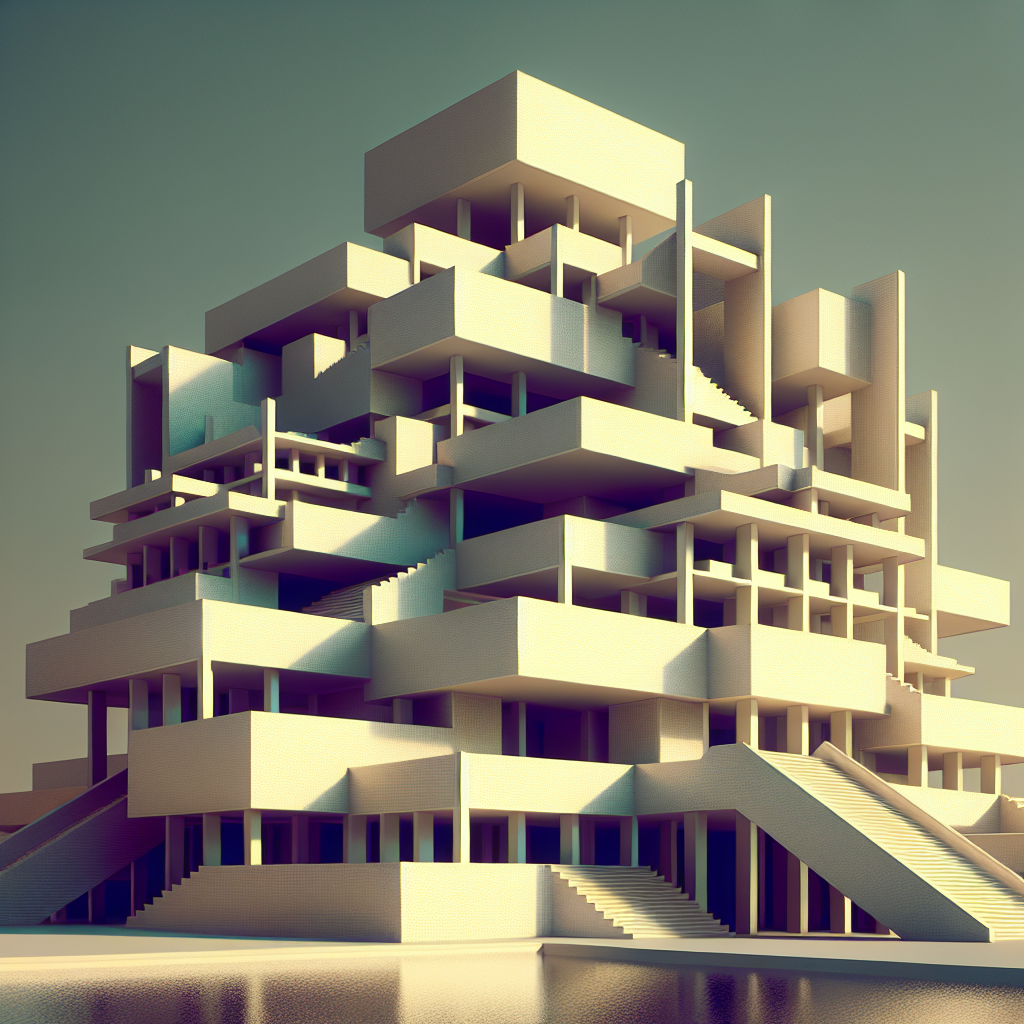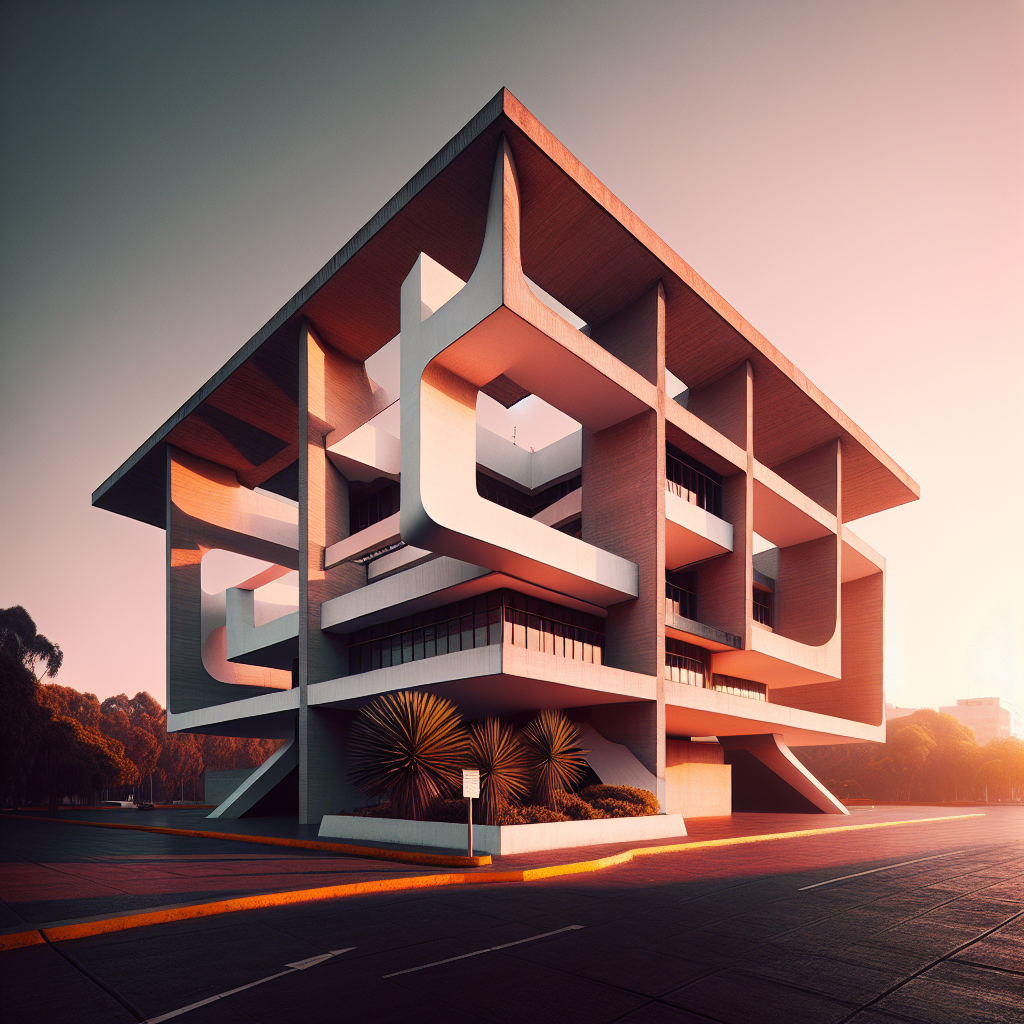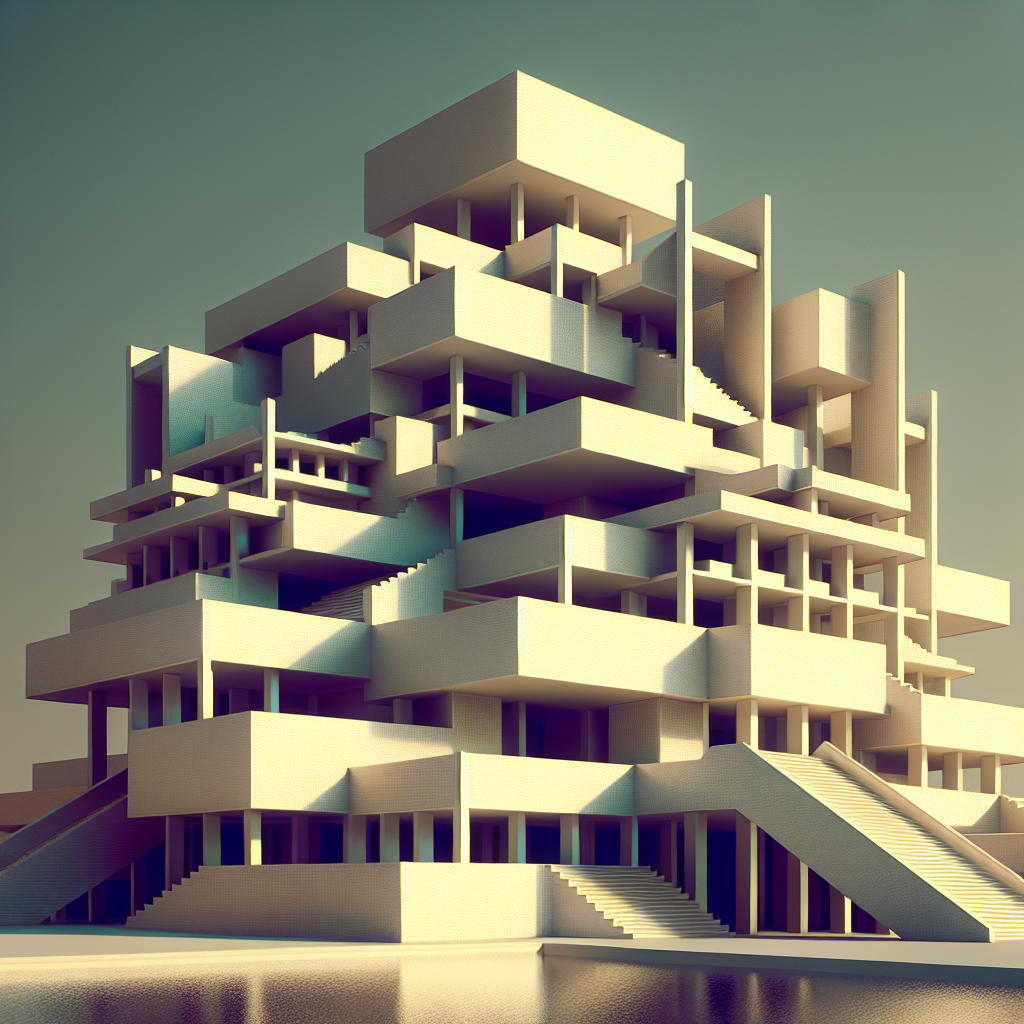So you’ve decided to embark on a journey to explore the architectural wonders of Mexico’s Modernist movement. From the vibrant streets of Mexico City to the serene coastal cities, this article will take you on a captivating tour of the country’s architectural marvels. Step into a world where bold lines and geometric designs seamlessly blend with Mexican cultural heritage, as we dive into the vibrant history and significance of Mexico’s Modernist architecture. Get ready to be transported through time as you discover the iconic buildings and structures that have shaped the urban landscape of this fascinating country.

I. The Birth of Modernist Architecture in Mexico
A. Influences and Origins
Mexico’s modernist architecture emerged in the early 20th century, drawing inspiration from several influential sources. One significant influence was the European modernist movement, which challenged traditional architectural norms and embraced new technologies and materials. Mexican architects such as Juan O’Gorman and Carlos Obregón Santacilia traveled to Europe, particularly to the Bauhaus school in Germany, where they were exposed to these progressive ideas.
Another key influence on Mexican modernist architecture was the rich cultural heritage and indigenous traditions of Mexico. Architects like Luis Barragán and Mario Pani incorporated elements of pre-Columbian architecture into their designs, creating a unique blend of modernism and Mexican identity.
B. Key Figures in the Modernist Movement
The modernist movement in Mexico was driven by visionary architects who played instrumental roles in shaping the country’s architectural landscape. Luis Barragán, widely regarded as one of Mexico’s most influential architects, brought a distinctive aesthetic to modernist architecture with his use of vibrant colors, simple geometric forms, and sensitivity to natural light and space.
Carlos Obregón Santacilia, another prominent figure, focused on urban planning and contributed significantly to the transformation of Mexico City. His designs embraced functionalism and integrated green spaces into the urban fabric, creating more livable environments for the city’s residents.
II. The Rise of Modernist Architecture in Mexico
A. Modernist Principles
Modernist architecture in Mexico was guided by certain core principles. These principles emphasized functionality, simplicity, and the rejection of ornate decoration in favor of clean lines and geometric shapes. Light and space played crucial roles, with architects employing innovative techniques to maximize natural light and create open, airy interiors. Materials such as concrete, steel, and glass were preferred for their versatility and ability to create sleek, minimalist designs.
B. Impact on Mexican Society
The rise of modernist architecture in Mexico had a profound impact on society. By challenging traditional architectural norms, it offered a departure from the colonial and neoclassical styles that dominated the landscape. Modernist buildings became symbols of progress and innovation, indicative of a modernizing society embracing the future.
Moreover, modernist architecture played a significant role in shaping the urban fabric of Mexican cities. It facilitated the construction of high-density housing, office buildings, and cultural centers, meeting the growing demands of a rapidly urbanizing population.
C. Modernist Architecture as a Political Statement
Modernist architecture in Mexico was also a means of expressing political ideologies. In the years following the Mexican Revolution, the government sought to redefine Mexico’s identity and promote a sense of national pride. Modernist architecture became a tool for nation-building and projecting a progressive image of Mexico to the rest of the world.
Architectural projects like the Ciudad Universitaria (University City) in Mexico City, designed by Mario Pani and Enrique del Moral, embodied this vision. The campus, with its modernist buildings and public spaces, aimed to promote education, culture, and a sense of collective identity.
III. Mexico City: The Epicenter of Modernist Architecture
A. Iconic Modernist Structures in Mexico City
Mexico City, with its rich architectural heritage and vibrant urban landscape, became the epicenter of modernist architecture in Mexico. The city boasts several iconic modernist structures that have become symbols of Mexican architectural excellence.
One such structure is the Museo Nacional de Antropología, designed by Pedro Ramírez Vázquez. This museum, dedicated to the country’s pre-Columbian history, showcases modernist design principles through its grand scale, use of reinforced concrete, and integration of outdoor spaces.
Another notable example is the Torre Latinoamericana, an emblematic skyscraper in the heart of the city. Designed by Augusto H. Álvarez, the tower stands as a testament to Mexican engineering prowess, featuring a modernist façade and panoramic views of the city.
B. The Influence of Modernism on Urban Planning
Modernist architecture had a profound influence on urban planning in Mexico City. The concept of creating functional, livable spaces took center stage, with architects and urban planners aiming to improve the quality of life for residents.
One notable urban planning project is the Ciudad Satélite, a planned community designed by Mario Pani and Enrique del Moral. It incorporated modernist principles to create a self-contained neighborhood with housing, schools, commercial areas, and green spaces. This innovative approach to urban planning became a model for future developments in Mexico City and beyond.
C. Modernist Architecture in the Historic Center
While modernist architecture is often associated with new construction, it also made its mark in Mexico City’s historic center. Architects like Pedro Ramírez Vázquez and Teodoro González de León embraced modernist principles when designing additions and renovations to existing historical structures.
For example, the renovation of the Palacio de Bellas Artes (Palace of Fine Arts) by González de León showcases a harmonious blend of modernist interventions with the original Art Nouveau design. This approach allowed for the preservation of historical significance while breathing new life into the iconic building.
IV. Guadalajara: A Hub of Modernist Design
A. Modernist Landmarks in Guadalajara
Guadalajara, the capital of the state of Jalisco, became a hub of modernist design in Mexico. The city boasts numerous landmarks that exemplify the modernist architectural movement.
One significant structure is the Hospicio Cabañas, a UNESCO World Heritage site designed by Manuel Tolsá. This former orphanage is known for its grand courtyard, vaulted ceilings, and murals by renowned Mexican artist José Clemente Orozco. The building’s clean lines and large windows demonstrate modernist principles while preserving historical elements.
Another noteworthy landmark is the Torres Minerva, a set of twin towers designed by Luis Barragán and Rafael Urzua. These skyscrapers, with their distinctive pink hue and geometric design, became symbols of modernity in Guadalajara.
B. The Integration of Modernism with Traditional Mexican Architecture
In Guadalajara, architects also explored the integration of modernism with traditional Mexican architecture. They sought to maintain a sense of continuity with the city’s historical context while embracing the principles of modernist design.
One example is the Escuela Preparatoria #4, designed by Ignacio Diaz Morales. This educational institution fuses modernist elements, such as clean lines and a rectilinear layout, with traditional Mexican architectural features like courtyards and arcades. The result is a harmonious blend of past and present, creating a unique architectural identity for Guadalajara.

V. Monterrey: Modernism in the North
A. Architectural Gems in Monterrey
Monterrey, located in northeastern Mexico, is another city known for its modernist architecture. The city’s industrialization and economic growth in the mid-20th century provided a fertile ground for the construction of architectural gems that embodied modernist principles.
One such gem is the Edificio Gómez Morín, designed by Mario Pani. This innovative office building features a reinforced concrete façade with large windows, allowing for natural light and views of the surrounding mountains. The building’s distinctive form and efficient use of space make it a standout example of modernist architecture in Monterrey.
Another notable structure is the Tower of the Bishopric, designed by Louis Kahn. Though not Mexican himself, Kahn’s contribution to modernist architecture in Monterrey cannot be overlooked. The tower, with its exposed concrete structure and geometric design, showcases Kahn’s mastery of minimalism and spatial composition.
B. Modernist Innovations in Industrial Architecture
Monterrey’s industrialization presented an opportunity for modernist architects to innovate in the field of industrial architecture. They aimed to create functional, aesthetically pleasing spaces that optimized productivity while reflecting the spirit of modernity.
One significant example is the Cerrey Boiler Manufacturing Plant, designed by José Villagrán García. This industrial facility embraced modernist principles, such as modular design and the use of prefabricated materials, to streamline production processes. The building’s sleek lines and large expanses of glass not only provided ample natural light but also visually connected the workers with the industrial processes taking place.
VI. The Impact of Modernist Architecture on Mexican Housing
A. Modernist Residential Developments
Modernist architecture in Mexico also left a lasting impact on residential developments. Architects sought to create innovative housing solutions that were functional, affordable, and capable of improving the quality of life for residents.
One notable example is the Unidad Infonavit Nonoalco Tlatelolco, designed by Mario Pani and Enrique del Moral. This social housing complex, built on a massive scale, introduced modernist principles to affordable housing. Its elevated walkways, green spaces, and efficient use of space allowed for the creation of a comfortable living environment for thousands of residents.
Another significant residential development is the Jardines del Pedregal, designed by Luis Barragán. This upscale neighborhood embraced modernist design while integrating elements of traditional Mexican architecture. Large gardens, water features, and careful attention to the relationship between indoor and outdoor spaces contributed to a unique residential experience.
B. Affordable Housing and Social Responsibility
Modernist architecture in Mexico also aimed to address issues of affordable housing and social responsibility. Architects recognized the importance of designing housing that catered to the needs of the marginalized and underserved populations.
Architects like Abraham Zabludovsky were instrumental in designing innovative housing solutions. His Tlatelolco Housing Complex, completed in the 1960s, featured a series of interconnected towers that provided housing for low-income families. The design employed prefabricated elements to streamline construction and reduce costs without compromising quality.
By prioritizing affordability, functionality, and social responsibility, modernist architecture in Mexico played a significant role in improving the living conditions of many Mexicans.
VII. Modernist Architectural Preservation and Heritage
A. Challenges in Preserving Modernist Buildings
Preserving modernist architecture in Mexico is not without its challenges. Many modernist buildings face threats of demolition or insensitive renovations due to shifts in architectural tastes and changing urban needs.
One key challenge is the perception that modernist buildings lack historical and cultural value compared to older, more ornate structures. This mindset often leads to neglect or disregard for these architectural treasures when it comes to preservation efforts.
Additionally, the use of modernist principles, such as the extensive use of concrete and glass, poses unique preservation challenges. The deterioration of concrete and issues related to energy efficiency and climate control require careful consideration when developing preservation strategies for modernist buildings.
B. Efforts in Modernist Architectural Conservation
Despite these challenges, there are ongoing efforts to preserve and conserve Mexico’s modernist architectural heritage.
Organizations like DOCOMOMO Mexico (Documentation and Conservation of Buildings, Sites, and Neighborhoods of the Modern Movement) play a vital role in documenting and raising awareness about endangered modernist buildings. They advocate for the preservation and adaptive reuse of these structures, ensuring their continued relevance in the built environment.
Prominent universities, museums, and cultural institutions also contribute to the preservation of modernist architecture by hosting exhibitions, workshops, and lectures that celebrate the accomplishments of modernist architects.
VIII. Modernist Architecture and Tourism in Mexico
A. Modernist Architecture as a Tourist Attraction
Mexico’s modernist architecture has become a significant draw for tourists seeking to explore the country’s cultural and architectural heritage. Visitors are captivated by the striking aesthetics, functional design, and historical significance of modernist buildings.
Tourists often flock to Mexico City to visit iconic modernist structures like the Museo Frida Kahlo (Frida Kahlo Museum) and the Casa Luis Barragán. These buildings allow visitors to immerse themselves in the distinct atmosphere and design elements of Mexican modernism.
Mexico’s modernist architecture also serves as the backdrop for architectural tourism events, such as open-house tours and exhibitions, which provide visitors with a deeper understanding of the movement’s impact on the country’s urban landscape.
B. Modernism in the Context of Mexican Tourism Industry
The prominence of modernist architecture in Mexico has had implications for the country’s tourism industry. Tourists interested in architecture and design now have a compelling reason to visit Mexico, contributing to the growth of cultural and heritage tourism.
The demand for guided tours, specialized travel agencies, and curated experiences centered around modernist architecture has increased. This trend not only stimulates local economies but also promotes awareness and appreciation for the country’s architectural heritage.
The Mexican tourism industry has recognized the value of modernist architecture as an asset and leverages it to attract international visitors interested in exploring the country’s architectural marvels.
IX. Mexican Modernist Architecture Goes Global
A. International Recognition of Mexican Modernist Architects
Mexican modernist architects have gained international recognition for their contributions to the architectural field. Their designs have resonated with audiences worldwide, and their influence can be seen in the work of architects around the globe.
Luis Barragán, in particular, received global acclaim for his exceptional architectural vision. He was awarded the Pritzker Architecture Prize in 1980, becoming the first Mexican architect to receive this prestigious honor. Barragán’s legacy continues to inspire architects worldwide, with his ideas and design principles transcending borders.
B. The Legacy of Mexican Modernism in Architectural Movements Worldwide
Mexican modernism left a lasting legacy that influenced architectural movements worldwide. The fusion of modernist principles with indigenous traditions and vernacular architecture became a source of inspiration for architects seeking to create a regional identity while embracing modernity.
Postmodern architecture, for example, drew from the Mexican modernist movement by incorporating historical references and contextual elements into contemporary designs. This approach allowed for a more nuanced and localized interpretation of modernism, breaking away from the uniformity often associated with the movement.
The impact of Mexican modernism can also be seen in the work of Latin American architects such as Oscar Niemeyer in Brazil and Ricardo Legorreta in Mexico, who drew inspiration from the country’s vibrant modernist legacy.
X. The Future of Modernist Architecture in Mexico
A. Contemporary Examples of Modernism in Mexico
While the heyday of Mexican modernism may have passed, contemporary architects continue to draw inspiration from its principles. They reinterpret modernism in the context of current challenges, such as sustainability, climate change, and social equity.
Architects like Alberto Kalach and Michel Rojkind are at the forefront of contemporary Mexican architecture, exploring new approaches to modernism. Their designs often incorporate sustainable features, utilize local materials, and respond to the evolving needs of Mexican society.
B. Reimagining Modernist Architecture for Sustainable Development
The future of modernist architecture in Mexico lies in the reimagining of its principles for sustainable development. Architects are increasingly integrating green technologies, renewable materials, and energy-efficient systems into modernist designs, creating buildings that are not only visually striking but also environmentally responsible.
In addition, the principles of social equity and inclusivity are being woven into contemporary modernist designs. Architects are prioritizing the creation of spaces that are accessible, adaptable, and responsive to the diverse needs of users, fostering a sense of community and wellbeing.
As Mexico continues to evolve and face new challenges, modernist architecture serves as a foundation for innovative design solutions that address the needs of a dynamic society, while preserving the country’s rich architectural heritage.
